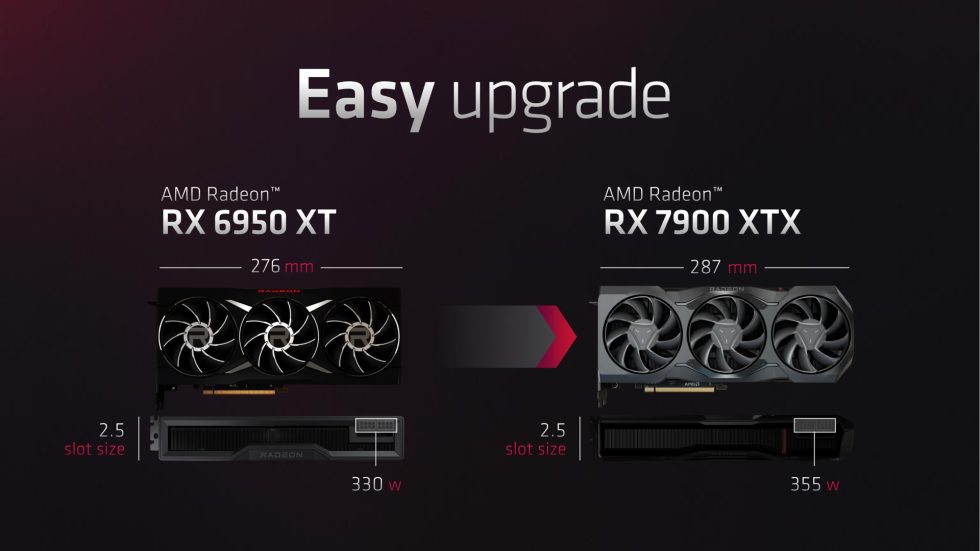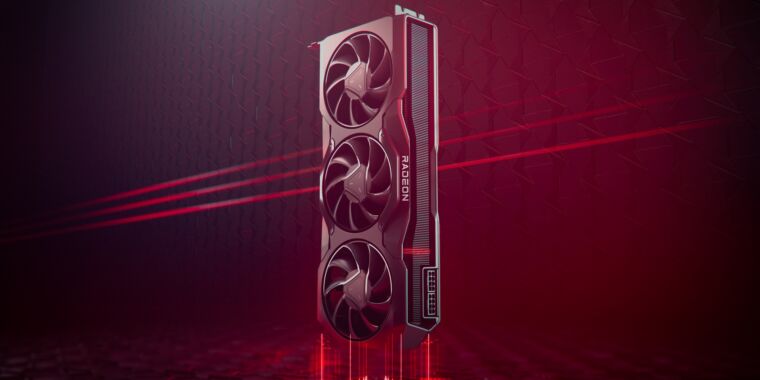AMD
AMD is gearing up to launch its next-generation Radeon RX 7000-series GPUs next month, and today the company shared more details about the cards’ pricing, performance levels, and the new RDNA 3 GPU architecture that will power all of its graphics cards for the next couple of years.
The launch begins at the high end, with the Radeon RX 7900 XTX and RX 7900 XT. AMD will launch both of these GPUs on December 13, with the 7900 XTX starting at $999 and the XT starting at $899 (cards made by AMD’s partners will surely push these prices upward a bit). Both of these price tags undercut Nvidia’s RTX 4000 series, which starts at $1,599 for the top-tier GeForce RTX 4090 and $1,199 for the RTX 4080.
| CPU | Launch MSRP | CUs | Game clock | RAM/bus width | TBP |
|---|---|---|---|---|---|
| Radeon RX 7900 XTX | $999 | 96 (RDNA 3) | 2300 MHz | 24GB GDDR6 (384-bit) | 355 W |
| Radeon RX 6950 XT | $1,099 | 80 (RDNA 2) | 2100 MHz | 16GB GDDR6 (256-bit) | 335 W |
| Radeon RX 7900 XT | $899 | 84 (RDNA 3) | 2000 MHz | 20GB GDDR6 (320-bit) | 300 W |
| Radeon RX 6800 XT | $649 | 72 (RDNA 2) | 2015 MHz | 16GB GDDR6 (256-bit) | 300 W |
Nvidia had planned to field a 12GB version of the RTX 4080 in this price range, but a consumer backlash to its potentially confusing branding and lower performance level prompted Nvidia to “unlaunch” the card, with no word on when it will be re-introduced, what it will be called, or what it will cost. The 16GB version of the 4080 launches November 16, beating AMD’s new GPUs to market by around a month.
-
AMD didn’t spend any time comparing the new Radeon cards to any Nvidia GPUs, opting instead to compare them to their predecessors.
AMD -
The 7900 XTX is the new flagship of the series.
AMD -
The 7900 XT is a small step back in memory capacity, bus width, clock speed, CUs, and power consumption for $100 less.
AMD
When it came to comparing its cards against Nvidia’s, AMD played coy during its presentation, carefully comparing the RX 7900 XTX series to the RX 6950 XT without mentioning either the RTX 3000 series or the RTX 4000 series. The 7900 XTX is said to be “up to 1.7x” faster than the 6950 XT while playing games in 4K—a 1.5x improvement was more common among the games AMD tested.
In terms of raw compute performance, AMD says the 7900 XTX is capable of up to 61 teraflops of performance, while Nvidia says the RTX 4090 is capable of 83 teraflops and the RTX 4080 of 49 teraflops. This is a super high-level performance number that doesn’t tell us a lot about how the cards will compare in real games (the RTX 4090 is not 70 percent faster than the RTX 4080, according to Nvidia’s own benchmarks). But along with the pricing and lack of head-to-head 4090 comparisons, this vague number does suggest that AMD is aiming at Nvidia’s 4080 tier with these cards rather than trying to outperform the RTX 4090. This is the same relative position that AMD has been in for a few generations now.
A bag of chiplets
-
A fully enabled RDNA 3 GPU, as used in the RX 7900 XTX.
AMD -
AMD is using chiplets in the RX 7000 series, but all of the compute resources are still in one big die.
AMD -
The GCD is where most of the hardware lives, including the display controller and media encoding engine.
AMD -
The 6nm MCDs are for “up to” 16MB of Infinity Cache and memory controllers, which will make it pretty easy for AMD to scale down for lower-end products.
AMD -
Moving from a 7nm process to 5nm has upped RDNA 3’s transistor density.
AMD -
Stream processor improvements.
AMD -
RDNA 3 includes two AI accelerator units per CU.
AMD
As expected, the RDNA 3 GPUs will take a page out of Ryzen’s book, using a group of chiplets rather than a single large slab of silicon like Nvidia is using. By making a GPU out of many smaller interconnected silicon dies, AMD can potentially reduce the cost and improve the yields of its GPUs by ensuring that less silicon is thrown out or binned because of small imperfections or defects.
Unlike in Ryzen, where the actual CPU cores are split among multiple chiplets, AMD is still putting all of the GPU’s actual processing power into a single piece of silicon called the Graphics Compute Die, or GCD. Manufactured using TSMC’s 5 nm process, the GCD contains all of the actual RDNA 3 compute units, plus the display engine (for controlling video output) and the media encoding and decoding engine.
The other chiplets in each GPU are smaller Memory Cache Dies, or MCDs; these each contain a 64-bit memory controller plus Infinity Cache memory. The 7900 XTX has six of these MCDs lit up, while the 7900 XT has five of them (you can tell because the XTX has a 384-bit memory bus, while the XT has a 320-bit bus). AMD is building the MCDs on a 6 nm manufacturing process, like the I/O die in the Ryzen 7000 CPUs.
-
AMD focused on improving RDNA 3’s ray-tracing performance, and each CU should be capable of up to 50 percent more performance than in RDNA 2.
AMD -
AMD’s ray-tracing improvements as compared in actual games.
AMD
Aside from improving framerates, RDNA 3 focuses on increasing RDNA 2’s mediocre ray-tracing performance. Compared to Nvidia’s RTX 3000-series and Intel’s Arc GPUs, AMD’s RDNA 2 ray-tracing accelerators handled fewer steps of the ray-tracing pipeline—specifically, they offloaded something called “tree traversal” to the general-purpose stream processors, while Nvidia’s and Intel’s ray-tracing units handled traversal themselves. RDNA 3’s ray-tracing accelerators do handle this traversal, which, along with other improvements, should be good for “up to 50% more [ray-tracing] performance per CU,” according to AMD.
The GPU’s media encoding capabilities are also getting a boost. Most notably, they’ll catch up to the RTX 4000-series and Intel’s Arc cards by supporting hardware-accelerated encoding and decoding of AV1 video streams (up to 8K at 60 FPS, similar to what Nvidia and Intel offer). RDNA 2 GPUs only support hardware-accelerated decoding of AV1 videos. And AMD noted that the new GPUs support the DisplayPort 2.1 spec, which will enable higher refresh rates on DisplayPort 2.1-capable monitors when they’re more widely available.

AMD
Although its announcement was light on performance comparisons, AMD took potshots at the sheer size and power requirements of Nvidia’s RTX 4090, demonstrating that AMD’s 7900 XTX reference design could easily replace an RX 6950 XT without requiring an upgraded power supply, a power cable adapter, or a larger case. Peak power consumption goes up from 330 W to 355 W—still an increase but around 100 W lower than the RTX 4090’s peak power consumption and still capable of being powered by a pair of 8-pin PCIe power connectors.
On the software side, AMD teased a next-generation version of its FidelityFX Super Resolution (FSR) upscaling technology, which it says is “coming in 2023” and will deliver “up to 2x more FPS vs FSR 2” at 4K resolutions. FSR 2 helped to close the visual quality gap between the first version of FSR and Nvidia’s similar DLSS upscaling tech while also running on more GPUs, including older Radeon GPUs and many Intel and Nvidia GPUs. We don’t yet know whether FSR 3 will also be GPU-agnostic or if AMD will restrict it to the latest-generation Radeon GPUs as Nvidia does with DLSS 3 and the RTX 4000-series.
We’ll be taking a closer look at AMD’s Radeon RX 7000-series cards when they’re a bit closer to launch.

